All published articles of this journal are available on ScienceDirect.
Rural Youth Employability Trends and the COVID-19 Pandemic
Abstract
Background:
The COVID-19 pandemic seriously impacts youth employability, especially in rural regions. In rural areas, the lack of system and availability of education, vocational education and training can have a negative impact on a young person's ability to obtain an education and continue to succeed in the labour market. These circumstances can hinder a young person's transition to the labour market.
Aims and Objectives:
The paper presents a brief analysis of rural youth employment trends, the consequences of the COVID-19 pandemic for the labour market in Latvia, and an analysis of the youth employability using dynamic series analysis.
Methods:
The research methodology implemented for the present research study is based on the theoretical concepts and statistical data regarding the rural youth employment trends and the impact of the COVID-19 pandemic.
Results:
Based on the results of the research study, it can be concluded that COVID-19 has contributed to job losses by forcing young people from rural areas to move to a city with better access to employment. The authors have concluded that educated women tend to start their own businesses after graduation, which is positive, especially if it is based in rural areas.
Conclusion:
Based on the authors' calculations, the forecast of employees in the age group from 25 to 34 in Latvia in 2022 is 171.9 thousand, in 2023, it is 156.5 thousand, and in 2024 it is 138.9 thousand. It could be concluded that the projected number of employees in the 25-34 age group will decrease significantly.
1. INTRODUCTION
The COVID-19 pandemic has serious consequences for the future integration of young people into the labour market, especially in rural areas. According to the International Labour Organization, “about one in five young people in the world is out of work, in education or training, and there are two times more young women than young men. In addition, youth unemployment is about three times higher than that of adults” [1]. The COVID-19 crisis has exacerbated this already difficult situation and increased youth unemployment, as well as the vulnerability of young people in the labour market.
The main challenges faced by young people in rural areas are access to adequate educational opportunities, finding a job, barriers to social inclusion, limited opportunities for participation and insufficient participation in social life, the provision of infrastructure, access to services etc [2].
The COVID-19 pandemic has created more barriers for young people from rural areas to access the same opportunities as compared to young people in the city. An exception is the possibility of remote access to education, which was directly facilitated by the COVID-19 pandemic and was not previously possible due to geographical or economic barriers [3].
The aim of the research is to analyse rural youth employment trends and the impact of the COVID-19 pandemic in Latvia, as well as to forecast youth employability trends.
The following tasks are set to achieve the aim:
(1) To evaluate theoretical findings on rural youth employability and integration into the labour market by various authors.
(2) To analyse statistical data on youth employment.
(3) To analyse youth employability by using dynamic series analysis
The novelty of the research: a forecast on employment of youth from 15 to 24 years and 25 to 34 years for a period from 2022 to 2024 in Latvia.
1.1. Youth Employability in Rural Areas
Most European countries, including Latvia, are facing an aging population. Over the last ten years, the proportion of young people in the total population in Europe has fallen sharply. This is not the case only in cities but also in rural areas and is the result of low birth rates and youth migration [4].
The COVID-19 pandemic affects all parts of society and livelihoods around the globe. It is worth recognizing that disadvantaged segments of populations like young rural women and men will be impacted harder [5].
Young people, especially from rural areas, face several challenges for social inclusion, such as access to housing, limited access to education and services, a lack of medical services etc. The number of rural residents is decreasing, which is why the need for services is decreasing. The decline in the need for services in rural areas contributes to a reduction in employment opportunities [6].
The COVID-19 pandemic had a significant impact on the social inclusion of young people in rural areas. As a result of the COVID-19 pandemic, several companies went bankrupt and young people in the tourism, catering and accommodation sectors lost their jobs.
The situation caused by the COVID-19 pandemic was often worse for educated young women in rural areas who had difficulty finding work [6]. The changes in the labour market caused by COVID-19 have had a particularly negative impact on economic growth in rural areas and the prosperity of the rural population. For several years, the prevailing metrocentric trend has led young people to travel to cities for training or a profession. It is most often young women who choose to leave rural areas to live and study in the city and later pursue a career there, thus avoiding the traditional roles that dominate rural areas [7]. As a result, well-educated young women from rural areas look for better job opportunities in cities where they can develop their careers. The second option is that the young women with good education start their own business in a rural area and, as a result, also contribute to the development of the rural area.
According to author Furlong, “vulnerable and less qualified young people are also among those most affected by COVID-19 restrictions, especially those aged 15-34 who are not in employment, education, or training (NEET)” [8, 9].
According to authors Tanner and Arnett, “school to work transitions have changed dramatically over recent decades. The switch from an industrial to an information-based economy, the consequent need for higher levels of education, the feminization of the labour market and the more progressive views regarding intimacy and family formation have led to multiple, non-linear pathways for commuting between formal education and the workforce” [10].
According to the International Labour Organization, “in rural areas, the education, vocational education, and training system may already be disadvantaged by the underdevelopment or lack of certain services, so young people emigrate from rural areas to cities, and there is a risk that they will not return to the rural areas after completing education if employment conditions are not stable in the region” [11]. Skilled young people are more likely to move away from rural areas for better job opportunities. Rural areas face different labour market challenges [12].
Due to the declining rural population, any rural area has become a very disadvantaged area for public services, leading young workers to seek better education and employment opportunities to migrate from rural areas to cities. As a result, rural areas are under constant pressure to attract and retain educated young people to help balance the aging population, fulfill labour shortages, and stimulate economic development in rural regions [13]. Young people (especially women) from rural areas tend to focus on vocational training to address job shortages. However, these young people are significantly affected by a correlation between access to education and meeting labour market requirements, which is difficult to achieve in rural areas [14].
Author Struffolino notes that “while factors, such as gender and class, still play an important role in structuring the transition from school to work, many authors have argued that the transition for young people has become more difficult. University careers, parental backgrounds and local economic opportunities may lead graduates to experience different outcomes in the rural labour market” [15]. For example, it is easier for young people from rural areas with wealthy parents to get a good education and integrate into the international work environment. On the other hand, it is more difficult for a young person from a disadvantaged family in rural areas to obtain a good education, as they face many challenges, such as funds for education, funds for housing, transport costs, food costs, access to international education etc.
According to authors Leibert, Farrugia and Simones, “the employment structure in rural areas has become more unbalanced, focusing on offering low-skilled or male-dominated jobs in agriculture or small sectors” [7, 16, 17].
Referring to authors Farrugia and Simoes, rural youth have a negative self-perception. Often rural young people see themselves as underqualified and dependent on their families and have failed to fulfill the prophecy of success by moving to the city to complete post-secondary studies [16, 18]. This experience creates a sense of failure and a lack of control over the present and the future. As a result, many give up seeking training and employment opportunities, including in agriculture [19].
1.2. The Importance of Youth Entrepreneurship
Entrepreneurship is seen as one of the ways to develop rural areas and improve the economic situation in the regions, given the declining rural population [20]. If the region develops entrepreneurship, the region will also be more economically attractive to the population. Young people are among the potential residents who could develop their businesses.
According to the International Labour Organization, the labour force in agriculture is shrinking across Europe, which is a serious problem. In 2017 agricultural activity accounted for 16% of total employment in middle-developed countries and 3% in advanced countries [21]. Along with the economy and job prospects in rural communities, agriculture still dominates in Europe [22]. Despite this, the industry is having difficulty attracting new professionals, especially young people [23].
Direct or indirect restrictions exist for youth involvement in agriculture, such as:
- A mismatch between the professional expectations and opportunities of young people offered by primary sector activities,
- Lack of family background in agriculture,
- The Common Agricultural Policy,
- Support for starting a business for young people in agriculture,
- Industry demand in the region [18, 24].
Many authors have emphasized in their research that youth entrepreneurship is increasingly recognized as an opportunity to address economic issues, such as job shortages and regional development [25-28].
Research has increasingly emphasized that youth entrepreneurship and the effective preparation of a youth workforce are increasingly positioned as an important part of the development and revitalization of entrepreneurship. Young people are considered to have the opportunity to make a unique contribution to economic development [26]. At the same time, researchers point out that young people in rural areas are particularly vulnerable to not feeling part of their region. The recent demographic trend suggests that young people tend to leave rural areas and are afraid to return and consider entrepreneurship because it is not stable [29].
However, author Honjo considers that entrepreneurship can be seen as an alternative professional choice that promotes the use of human capital. In recent years, several factors have inspired people to start their own businesses. Today's young people have the necessary professional skills and knowledge to make themselves more capable of setting up and running their businesses [30].
Several studies in recent years have shown that the region where an individual lives is a crucial factor in explaining the differences in the level of entrepreneurial activity between individuals [31, 32].
Authors North, Smallbone and Melecki considered that the start-up of a business among young people could be influenced by the area in which the young person lives and the degree to which the young person is socially active in their region [32, 33].
A positive aspect of starting a business is that young people can also have a unique attitude and motivational strengths, such as greater responsiveness to new information and technologies compared to their older counterparts, which could be one of the reasons for successful rural business development and adaptation to new technologies [34].
Referring to a study by De Guzman, Kim, Taylor and Padasas (2020), business owners agreed that young people have great potential to help with technology and social media and that they could offer fresh perspectives on various aspects of their operations. Business owners also reported that they believe it is important to empower young people to learn about entrepreneurship and business management through practical experience [28].
Based on the research, it must be concluded that the social attitude towards entrepreneurship has changed. For example, more companies accept entrepreneurship by starting a new business [35-37]. National development agencies also play an important role in promoting youth entrepreneurship. For several years, the European Commission's support programs have focused on developing and implementing youth entrepreneurship programs. However, this is a more detailed issue and will not be discussed in the present paper.
In general, the development of youth entrepreneurship would clearly enable regions to develop.
In addition, it is easier for young individuals to start a paid career than for older people if they fail to set up their own businesses.
2. MATERIALS AND METHODS
2.1. Research Methodology
The monographic and descriptive methods, the methods of synthesis and logical construction, statistical data analysis as well as scientific discussion were applied to achieve the aim and perform the tasks.
2.2. The Theoretical Framework of the research
The research is based on other scientific research works and findings in the economic field and policy documents were used.
2.3. Data Series Analysis
Several statistical indicators are used to describe changes in data series. The indicators are divided into annual and base years according to the nature of their calculation.
For a data series analysis, data from the Central Statistical Bureau of Latvia on changes in employability were used from 2012 to 2021.
For statistical analysis, data from the Central Statistical Bureau of Latvia (CSB) and the Official Statistics Portal of Latvia were used.
3. RESULTS AND DISCUSSION
3.1. Statistical Analysis of Current Youth Employability Trends in Latvia
According to Eurostat, in the European Union, the number of young people and the share of young people in the total population have decreased in recent years (2013-2019), which means that the working-age population will be relatively small in the future. The Eurostat data showed that the number of young people aged 15-24 has fallen in most European Union countries. The number of young people has decreased in all age groups (15-24 and 25-29 years), yet the largest changes have been observed in the age group 15-24 years. In recent years, the number of young people in the EU-28 (2013-2019) has decreased from 3622.3 to 1890.2 million, and in the age group 25-29 from 6949.2 to 5881.3 million [6].
At the beginning of 2019, 122 thousand young people aged 18–24 lived in Latvia. This is almost twice less than in 2009, when there were 238 thousand young people in Latvia, according to data compiled by the Central Statistical Bureau of Latvia. The number of young people in Latvia is declining faster than the population, so their share in the total population is shrinking significantly. In 2009, young people represented 11% of the total population of Latvia; in 2019, it was only 6.4%, and this is the second lowest indicator in the European Union [38].
The proportion of young people in the regions varies; it is slightly higher than the average in Latvia: in Kurzeme (7.2%), Vidzeme (7.1%), Zemgale (6.75) and Latgale. In Pieriga (6%) and the capital city of Riga (5.8%), it is lower than the national average (6.4%). Among the cities of national significance, the largest share of young people is in Liepaja (6.9%), and the smallest is in Jurmala (5.3%). In contrast, the largest proportion of young people is reported in Jaunpiebalga (9%), Rugaji (8.9%), Riebini (8.7%), Varkava (8.7%), Broceni (8.3%), and Naukseni (8.3%) municipalities [38].
In Latvia, when they reach adulthood, young people, especially young men, are in no hurry to leave their parents' homes. At the beginning of 2019, 83.7% of young men and 73% of young women lived with their parents. Of the total, 2.9% of men and 7.4% of women were married, while 6.9% of men and 20.4% of women indicated that they lived in the same household as a partner or spouse [38].
Consequently, it should be emphasized that the problem with the proportion of young people in the total population is very acute, and it is important that young people are able to enter the labour market effectively.
Fig. (1) shows that the number of employed persons in the age group from 15 to 24 decreases yearly; for example, in 2012, the number of employed persons was 72.4 thousand, while in 2021, it was only 48.0 thousand, which was 24.4 thousand less compared to 2012.
The situation regarding the number of employed persons in the age group from 25 to 34 years is slightly different. In 2012, the number of employed persons in this age group was 208.4 thousand, while in 2015, it was more than 219.3 thousand. After 2015, the number of employees in this group also decreased, and in 2021, it was 184.2 thousand.
According to the statistical data, the number of employed persons decreases yearly in both age groups.
According to Fig. (2), in 2011, the largest total number of unemployed persons from 15 to 74 years in Latvia was 16.3%. In 2020, the total number of unemployed persons compared to 2019 increased from 6.3% in 2019 to 8.1% in 2020.
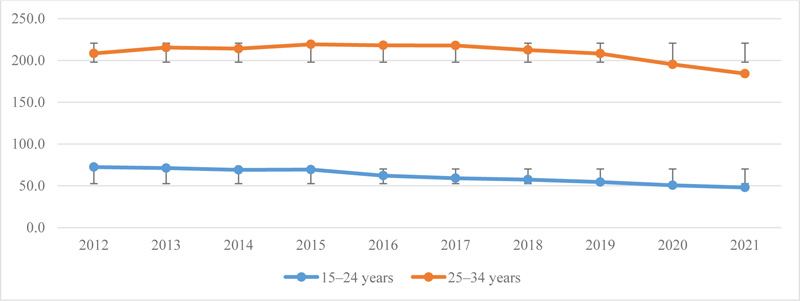
Source: Official statistics portal. Official statistics of Latvia, 2022 [39].
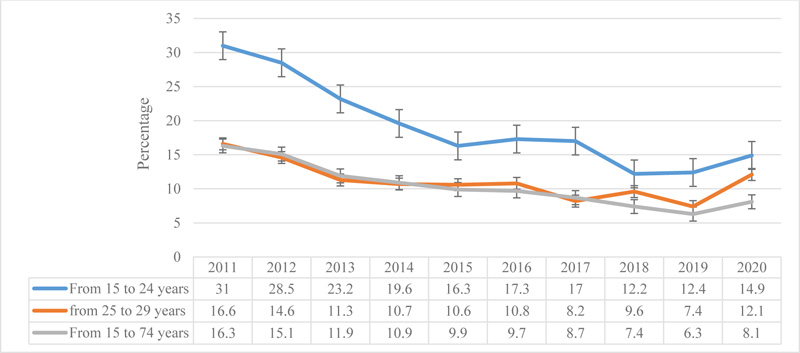
The highest unemployment of youth from 15 to 24 years was 31% in 2011, while in 2020, it was 14.9%. In 2020 compared to 2019, youth unemployment in this age group increased by 2.5%.
The unemployment of youth from 25 to 29 years was higher in 2011- 16.6%; in 2019, it was relatively low, i.e., 7.4%, while in 2020, it increased by 4.7% and reached 12.1%.
It must be concluded that total unemployment and youth unemployment will increase from 2020 onwards due to the current economic situation.
Although in recent years, there has been a decrease in the proportion of young people who are not in education, employment, or training (NEET) in Latvia, in 2020, during the pandemic, when restrictions were set to reduce COVID-19 in Latvia, and the unemployment rate increased, the number of young people who were NEET increased from 10.3% in 2019 to 11.9% in 2020.
The impact of changes on the labour market was observed among young people aged 25-29 compared to young people aged 15-24, many of whom were still getting an education. In 2020, the proportion of young people who were NEETs aged 25-29 was 19.5%, but only 7.1% for those who were NEETs aged 15-24 (Fig. 3). Therefore, there were fewer NEETs aged 15-24, as a large proportion of this age group were still getting an education and not working.
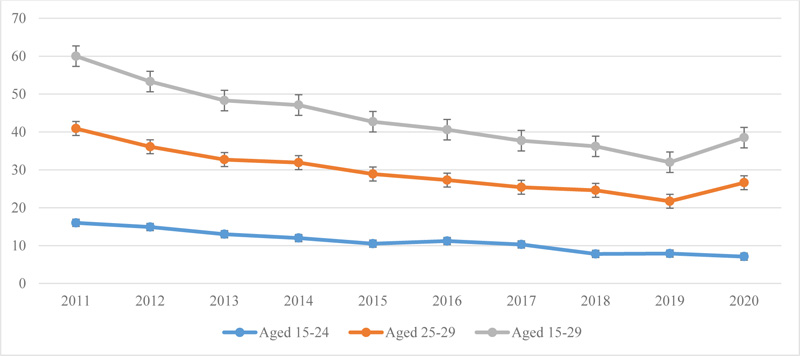
Source: Official statistics portal. Official statistics of Latvia, 2022 [42].
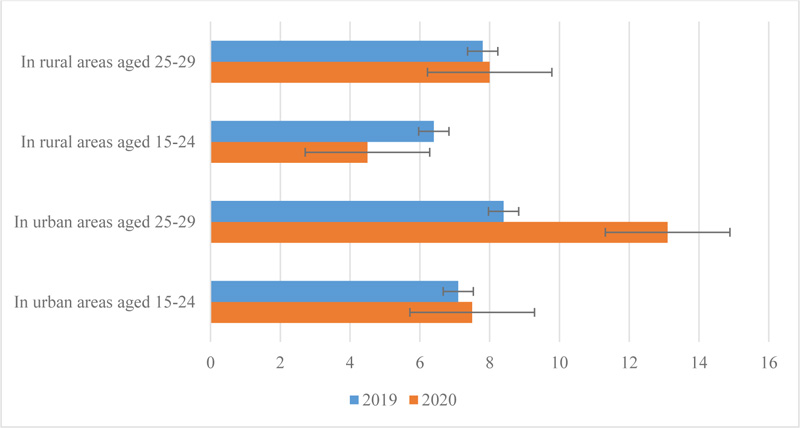
Source: Official statistics portal. Official statistics of Latvia, 2022 [43].
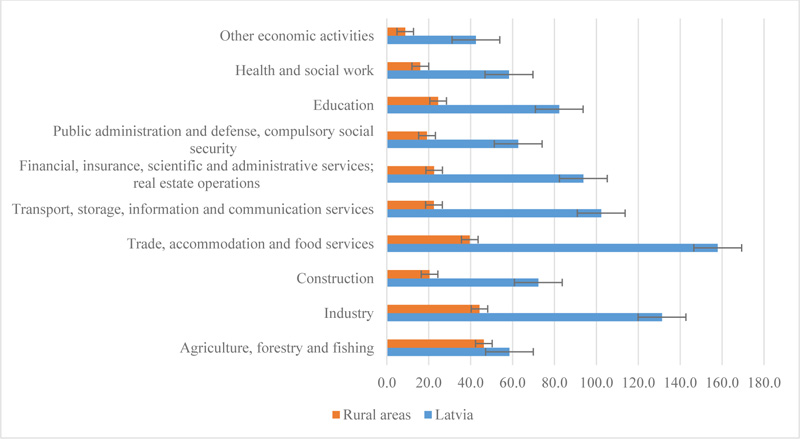
Source: Authors’ compilation based on the Central Statistical Bureau of Latvia, 2022 [44].
A comparison of young people in urban and rural areas in Latvia revealed that COVID-19 restrictions had a greater impact on young people living in urban areas. In 2020, the number of young people aged 15-24 who were not in education, employment, or training in urban areas increased by 5.6% (7.1 thousand in 2019, 7.5 thousand in 2020), while it continued to decrease in rural areas (6.4 thousand in 2019, 4.5 thousand in 2020).
The number of young people aged 25-29 who were not in education, employment, or training in urban areas increased by 56% (8.4 thousand in 2019, 13.1 thousand in 2020), while in rural areas, they increased slightly by 2.6% (7.8 thousand in 2019, 8 thousand in 2020) (Fig. 4). It should be noted that the number of young people in cities was higher than in rural areas.
Statistics are not available separately, only for young people, so in this study, we analysed data regarding all employees. In total, the number of employees in Latvia in 2021 reached 864 thousand, of which 264.8 thousand were employed in rural areas (Fig. 5).

Source: Authors’ calculations based on the Central Statistical Bureau of Latvia, 2022 [39].
The largest number of employees in rural areas in 2021 was in agriculture (46.3 thousand), industry (44.2 thousand) and trade, accommodation, and food service activities (39.6 thousand). In Latvia as a whole, the largest share of employees was in trade, accommodation, and food service activities (157.9 thousand), industry (131.3 thousand) and transport, storage, information, and communication services (102.3 thousand).
The lowest share of employees was in other types of economic activity (8.8 thousand), health and social care (16 thousand) and, public administration and defence, compulsory social security (19.2 thousand). The situation is the same in Latvia as a whole, as the above-mentioned types of economic activity also have the lowest employment rate compared to the other types of economic activity (42.5 thousand), health and social care (58.3 thousand) and public administration and defence, compulsory social security (62.7 thousand) (Fig. 5).
3.2. An in-depth analysis of youth employment trends and future opportunities in the labour market
To identify in more detail the share of employed young people in the age groups of 15-24 years and 25-34 years in the labour market, the authors performed an analysis of data series using the data from the Central Statistical Bureau.
Source: Authors’ calculations based on the Central Statistical Bureau of Latvia, 2022 [39].
An analysis of the number of employees (in thousands) in the age group from 25 to 34 years revealed that the absolute change in 2021 was -11.1 thousand compared to the previous year and the absolute change from the base year was -24 thousand compared to 2012 (base year). This means that the number of young people in employment in the 25-34 age group is declining. In contrast, in 2015, the trend in this age group was the opposite; the absolute increase in the chain was 5.2 thousand, while the absolute increase from the base year was 11 thousand, indicating that in 2015 employment increased in this age group (Fig. 6).
It should be noted that, based on the authors' calculations, the trends in the number of employed young people aged 15-24 were the opposite. In 2015, the employment of young people aged 15-24 was lower; the absolute annual increase was 0.3 thousand, while the absolute increase from the base year was -3 thousand, indicating that employment decreased compared to the base year 2012. In 2021, however, the employment of young people aged 15-24 decreased even more significantly; the absolute annual increase compared to the previous year was 2.6 thousand, while the absolute increase from the base year was 24 thousand against the base year. This indicates that the number of young people in employment declined significantly each year in both age groups and that the situation was much better 10 years ago in youth employment (Fig. 7).
The authors also calculated the annual growth rate (%) and the growth rate from the base year (%) to find out the percentage decrease in employment.
In the age group from 15 to 24 years, according to the authors' calculations, the highest negative annual growth rate (%) was in 2016, when it was -10%, while the most positive indicator value, zero, was reached in 2015. However, the highest negative growth rate from the base year (%) in this age group was in 2021,i.e., - 33.7%, while the lowest growth rate (%) was -1.7% in 2013 (Fig. 8).
In the age group from 25 to 34 years, the highest annual growth rate was 3.4% in 2013, while the highest growth rate from the base year (%) was 5.2% in 2015. In 2021, the annual growth rate was -6%, and the growth rate from the base year was -11.6%. These results confirmed the declining trend in youth employment (Fig. 9).

Source: Authors’ calculations based on the Central Statistical Bureau of Latvia, 2022 [39].
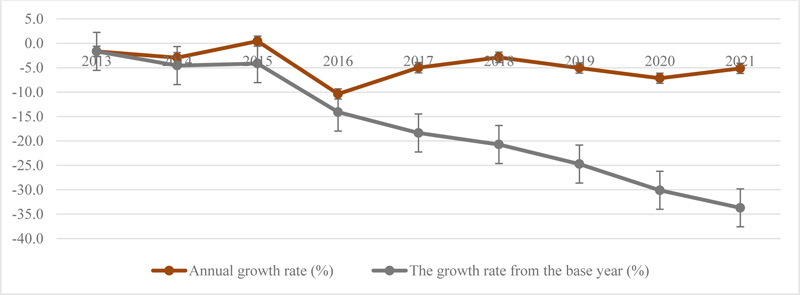
Source: Authors’ calculations based on the Central Statistical Bureau of Latvia, 2022 [39].
According to Fig. (10), a forecast of employees in the age group from 15 to 24 years in Latvia in 2022 is 45.5 thousand, 42.6 thousand in 2023 and 39.8 thousand in 2024. According to this figure, the number of employees aged 15-24 has been decreasing since 2015 (69.4 thousand), which can be assessed negatively. This means that the workforce will shrink yearly as the population shrinks.
According to Fig. (11), the forecast of employees in the age group from 25 to 34 years in Latvia in 2022 is estimated to be 171.9 thousand, 156.5 thousand in 2023 and 138.9 thousand in 2024. The projected number of employees in the 25-34 age group will also decrease significantly. In 2012, there were 208.4 thousand employees in this age group, while in 2015, there was an increase in employment to 219.3 thousand. In 2016, a decline in the number of employees aged 25-34 was reported, i.e., - 218.1 thousand, and this indicator is decreasing every year.
The authors have made calculations to predict the share of future employees. The forecast of employees in the age group from 15 to 24 in Latvia in 2022 is 45.5 thousand, 42.6 thousand in 2023 and 39.8 thousand in 2024. According to the research, the number of employees in the age group from 15 to 24 years (69.4 thousand) has been decreasing since 2015, and it can be assessed negatively. This means that the workforce will shrink yearly as the population shrinks.
The forecast of employees in the age group from 25 to 34 in Latvia in 2022 is 171.9 thousand, 156.5 thousand in 2023 and 138.9 thousand in 2024. The projected number of employees in the 25-34 age group will decrease significantly.
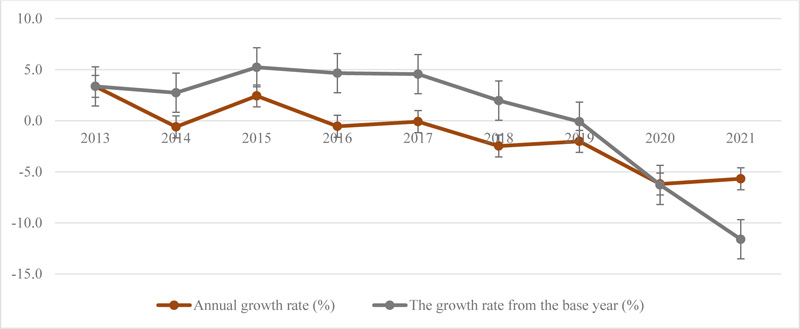
Source: Authors’ calculations based on the Central Statistical Bureau of Latvia, 2022 [39].

Source: Authors' calculations based on central Statistical Bureau of Latvia, 2022 [39].
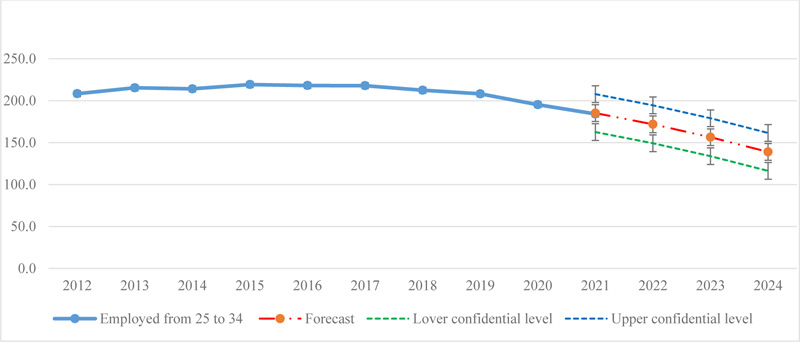
Source: Authors calculations based on central Statistical Bureau of Latvia, 2022 [39].
CONCLUSION
Rural youth are impacted greatly by the COVID-19 pandemic in respect of employment. COVID-19 has contributed to job losses, forcing young people from rural areas to move to a city with more access to employment. Based on the opinions of various authors, young people in cities also have the opportunity to gain better education and work experience, so some young people choose to move from rural areas to live in cities. This trend is particularly strong among women, as they are more educationally oriented and can avoid the narrow traditional roles that predominate in rural communities by leaving the rural areas. As a result, well-educated young women from rural areas are looking for better job opportunities in cities where they can develop their careers.
Women are also less likely to work in low-skilled jobs because they are better educated, unlike young men in rural areas. The authors have concluded that educated women tend to start their own businesses after graduation, which is positive, especially if it is based in rural areas.
Based on the collected opinions of the authors, it should be concluded that entrepreneurship is considered one of the ways to develop rural areas and improve the economic situation in the regions. If entrepreneurship develops in the region, the region will also be economically more attractive to residents, including young people. Young people are among the potential residents who could develop their businesses.
The involvement of young people in agriculture has several limitations, such as the mismatch between young people's professional aspirations and opportunities offered by rural regions, a lack of family origin in agriculture, the common agricultural policy, support for starting a business for young people in agriculture, demand in the region, etc.
Considering the calculations and the obtained results, it must be concluded that with the decrease in the share of young people in the total population, the number of employees also decreases every year, which is to be assessed negatively because the number of young people in Latvia is insufficient. As a result, the economy, including agricultural development, will be adversely affected.
Based on the results of the research, Latvia's rural areas are at risk, as educated young people tend to move to cities after graduation, and the number of young people in rural areas is declining significantly.
The creation of a special support policy for the social inclusion of young people in rural regions and the provision of support for starting a business, which could be a very important driving force in the development of rural regions, is recommended.
LIST OF ABBREVIATIONS
| NEET | = Not In Education, Employment, Or Training |
| CSB | = Central Statistical Bureau of Latvia |
ETHICS APPROVAL AND CONSENT TO PARTICIPATE
Not applicable.
HUMAN AND ANIMAL RIGHTS
No animals/humans were used in the studies that are the basis of this research.
CONSENT FOR PUBLICATION
Not applicable.
AVAILABILITY OF DATA AND MATERIALS
The authors confirm that the data supporting the findings of this study are available within the article.
FUNDING
The research was supported by the National Research Programme “Latvian Heritage and Future Challenges for the Sustainability of the State” and the project “Challenges for the Latvian State and Society and the Solutions in International Context (INTERFRAME-LV)”, grant number VPP-IZM-2018/1-0005.
CONFLICT OF INTEREST
The authors declare no conflict of interest, financial or otherwise.
ACKNOWLEDGEMENTS
Declared none.


